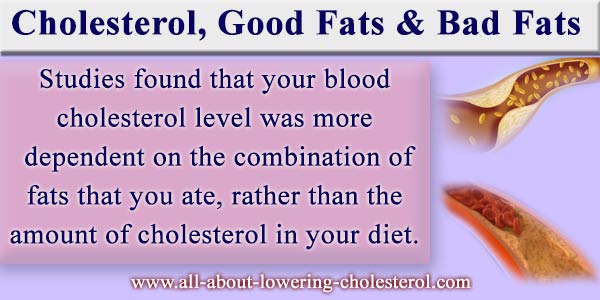
What is Cholesterol good and bad? If you’re looking to avoid fats because of high cholesterol, think again. Despite having high cholesterol, you can still eat fatty foods – this would include cholesterol and good fats, and bad fats?
To start with, you cannot avoid consuming cholesterol good fats bad fats because even the most low-calorie and healthy foods such as seafood, lettuce, and carrots contain some cholesterol or fat. Therefore, your goal should not be to completely cut these foods out of your diet, but rather to eat the right type of fats (good fats) and avoid bad fats.
That’s why in this article you’ll find out about the mistake of the low-fat revolution, plus the 5 types of fats: unsaturated, polyunsaturated, monounsaturated (these are good fats) and then saturated fats & trans fats (these last 2 are the bad fats).
Cholesterol and Fats – The Low Fat Revolution Resulted in Higher Cholesterol & Heart Disease
This is the most important part that you must understand about cholesterol and fats. Years ago, researchers started looking at the relationship between eating cholesterol and fats and heart health.
It was originally thought that consuming foods high in cholesterol and fats would increase the risk of heart disease as well as other serious health conditions such as obesity.
This early research sparked a low-fat revolution that had everyone counting fat grams. Unfortunately, heart disease and obesity continued to rise.
When the dust settled, researchers discovered that dietary cholesterol was not as significant as once thought.
Another revelation that researchers found was that the type of fat you eat is more important than the total amount of fat grams you consume.
Cholesterol and Fats – Dietary Cholesterol
Studies found that your blood cholesterol level was more dependent on the combination of fats that you ate, rather than the amount of cholesterol in your diet. (1)
You can add to your total blood cholesterol level by eating foods that contain cholesterol such as eggs, seafood (i.e. shrimp and lobster), and liver.
However, your body typically does not draw as much cholesterol out of your diet as it makes in your liver. So eating high cholesterol foods is not as damaging as eating bad fat foods.
FATS – Group 1: The 3 Good Fats
1. Good Unsaturated Fats for Lower Cholesterol
You want to add more unsaturated fats to your daily diet by consuming foods such as nuts, seeds, and some vegetable oils.
You will benefit because these good fats improve your cholesterol profile giving you more HDL “good” cholesterol and less LDL “bad” cholesterol.
2. Good Monounsaturated Fats
Your diet should include monounsaturated fats found in oils such as peanut, olive, and canola oils; as well as foods like avocados; nuts (i.e. hazelnuts, pecans, and almonds); & seeds (i.e. sesame and pumpkin seeds).
3. Good Polyunsaturated Fats
Your diet should also include polyunsaturated fats found in oils such as corn, flaxseed, soybean, and sunflower oils; as well as food items such as flax seeds, fish, and walnuts.
Your heart health can benefit from omega-3 fatty acids found in many polyunsaturated foods.
FATS – Group 2: The 2 Bad Fats – Saturated & Trans Fats
1. The Bad Saturated Fats
When you consider blood cholesterol and fats you want to cut back on saturated fats. This is one of the 2 types of bad fats. When you consume foods such as:
red meat, skin-on chicken, seafood, and full-fat dairy products, you are consuming saturated fats. You want to limit your consumption of these foods because saturated fats can elevate your total cholesterol and LDL “bad” cholesterol.
2. Worst of All-Trans Fats
You can complete your healthy diet picture by decreasing trans fats. You will find trans fats in foods like fried foods, packaged baked goods and snack foods, and margarine.
When you eat foods that contain trans fats you run the risk of increasing bad cholesterol and at the same time decreasing good cholesterol.
Cholesterol, Good Fats & Bad Fats – The Bottom Line
You will not be able to completely avoid foods that contain cholesterol and/or fat, but you can improve your blood cholesterol levels by limiting your intake of saturated and trans fats. Your body will handle foods with cholesterol and foods with unsaturated fats more favorably.
Or visit our homepage of All About Lowering Cholesterol.
References:
